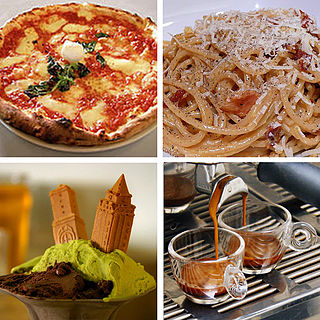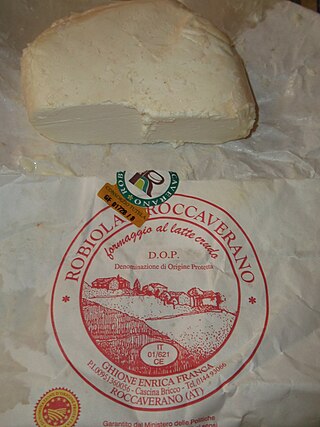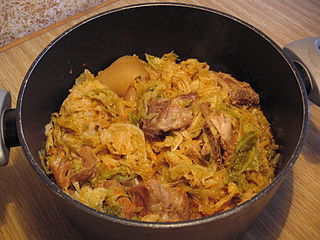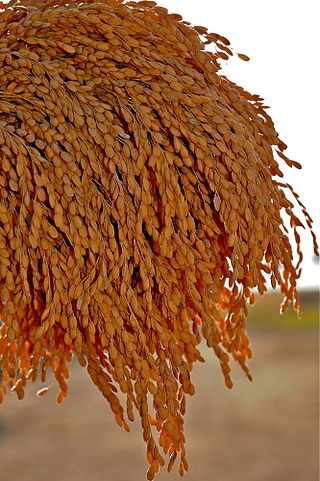
Pasta is a type of food typically made from an unleavened dough of wheat flour mixed with water or eggs, and formed into sheets or other shapes, then cooked by boiling or baking. Pasta was traditionally only made with durum, although the definition has been expanded to include alternatives for a gluten-free diet, such as rice flour, or legumes such as beans or lentils. While Asian noodles originated in China, pasta is believed to have developed independently in Italy and is a staple food of Italian cuisine, with evidence of Etruscans making pasta as early as 400 BCE in Italy.

Rice is a cereal grain and in its domesticated form is the staple food of over half of the world's population, particularly in Asia and Africa. Rice is the seed of the grass species Oryza sativa —or, much less commonly, Oryza glaberrima. Asian rice was domesticated in China some 13,500 to 8,200 years ago; African rice was domesticated in Africa about 3,000 years ago. Rice has become commonplace in many cultures worldwide; in 2021, 787 million tons were produced, placing it fourth after sugarcane, maize, and wheat. Only some 8% of rice is traded internationally. China, India, and Indonesia are the largest consumers of rice. A substantial amount of the rice produced in developing nations is lost after harvest through factors such as poor transport and storage. Rice yields can be reduced by pests including insects, rodents, and birds, as well as by weeds, and by diseases such as rice blast. Traditional rice polycultures such as rice-duck farming, and modern integrated pest management seek to control damage from pests in a sustainable way.

Risotto is an Italian rice dish cooked with broth until it reaches a creamy consistency. The broth can be derived from meat, fish, or vegetables. Many types of risotto contain butter, onion, white wine, and Parmesan cheese. It is one of the most common ways of cooking rice in Italy. Saffron was originally used for flavour and its signature yellow colour.

Arborio rice is an Italian short-grain rice. It is named after the town of Arborio, in the Po Valley, which is situated in the region of Piedmont in Italy. When cooked, the rounded grains are firm, creamy and chewy compared to other varieties of rice, due to their higher amylopectin starch content. It has a starchy taste and blends well with other flavours. Arborio rice is often used to make risotto; other suitable varieties include Carnaroli, Maratelli, Baldo, and Vialone Nano. Arborio rice is also usually used for rice pudding.

Italian cuisine is a Mediterranean cuisine consisting of the ingredients, recipes, and cooking techniques developed in Italy since Roman times and later spread around the world together with waves of Italian diaspora. Significant changes occurred with the colonization of the Americas and the introduction of potatoes, tomatoes, capsicums, maize, and sugar beet—the latter introduced in quantity in the 18th century. It is one of the best-known and most appreciated gastronomies worldwide.

Robiola is an Italian soft-ripened cheese of the stracchino family. It is from the Langhe region and made with varying proportions of cow's, goat's, and sheep's milk. One theory is that the cheese gets its name from the comune (municipality) of Robbio, in the province of Pavia; another that the name comes from the word rubeole (ruddy) because of the color of the seasoned rind.

Vincotto is a dark, sweet, thick paste produced in rural areas of Italy. It is made by the slow cooking and reduction over many hours of non-fermented grape must until it has been reduced to about one-fifth of its original volume and the sugars present have caramelized. It can be made from a number of varieties of local red wine grapes, including Primitivo, Negroamaro and Malvasia Nera, and before the grapes are picked they are allowed to wither naturally on the vine for about thirty days. In Roman times it was known as sapa in Latin and epsima in Greek, the same names that are often used for it in Italy and Cyprus, respectively, today.

Ptitim – sometimes called pearl couscous – is toasted pasta in tiny balls. Despite its name in English, it is not a type of couscous . The pearls are similar to the ones of the Maltese mhamsa.

The Segugio Maremmano is an Italian breed of scent hound from the coastal plains of the Maremma, in Tuscany. It is mainly used for hunting wild boar, but may also be used to hunt hare and other mammals. They may be either smooth-haired or rough-haired.

Venetian cuisine, from the city of Venice, Italy, or more widely from the region of Veneto, has a centuries-long history and differs significantly from other cuisines of northern Italy, and of neighbouring Austria and of Slavic countries, despite sharing some commonalities.

Lombard cuisine is the style of cooking in the Northern Italian region of Lombardy. The historical events of its provinces and of the diversity of its territories resulted in a varied culinary tradition. First courses in Lombard cuisine range from risottos to soups and stuffed pasta, and a large choice of second course meat or fish dishes, due to the many lakes and rivers of Lombardy.

Maratelli is a semifino rice native to the Asigliano Vercellese province of Vercelli in northern Italy. It is part of the group of ‘semi-fine’ rice. Compared to other Japonica varieties, it is early-ripening, it has a good yield and, in the right weather conditions, allows for the early use of fields for other successive cultivation. It is a stable rice genotype, hence maintaining constant culinary and botanical properties over time.
In agriculture, grain quality depends on the use of the grain. In ethanol production, the chemical composition of grain such as starch content is important, in food and feed manufacturing, properties such as protein, oil and sugar are significant, in the milling industry, soundness is the most important factor to consider when it comes to the quality of grain. For grain farmers, high germination percentage and seed dormancy are the main features to consider. For consumers, properties such as color and flavor are most important.

Vialone Nano is an Italian semifino (medium-grain) rice variety. It is typical of the flat, rice-growing areas of the southern province of Verona, in Veneto.
Vialone Nano is a cultivar of the Japonica group of varieties of Oryza sativa.

Arroz negro is a Mexican dish made with rice, in which its dark color comes from black bean broth. The dark broth is made by cooking black beans with onion and butter in sufficient water. Rice is fried with garlic, then the bean broth is added, as well as epazote, serrano pepper, and salt. The rice is simmered until tender.

Bomba rice is a short-grain variety of rice, primarily cultivated in the eastern parts of Spain. It is commonly used in paella and other dishes in Valencian cuisine, and is often referred to as Valencia rice. Bomba is considered a short to medium grain variety of rice, but unlike other short grain varieties, it has a relatively low content of Amylopectin, meaning it does not become sticky when cooked nor does it thicken the cooking fluid.

Huangjiu is a type of Chinese rice wine most popular in the Jiangnan area. Huangjiu is brewed by mixing steamed grains including rice, glutinous rice or millet with qū as starter culture, followed by saccharification and fermentation at around 13–18 °C (55–64 °F) for fortnights. Its alcohol content is typically 8% to 20%.

Paw san hmwe is a high-grade variety of aromatic rice grown in Myanmar. Paw hsan hmwe is known for its good cooking quality, fragrant aroma, texture, good milling recovery, and substantial grain elongation during the cooking process. The medium-length grains of this rice variety can elongate up to three times in length while cooking. Paw hsan hmwe has intermediate amylose content, higher than jasmine rice, contributing to its hardness quality in line with Burmese consumer preferences. Myanmar's Paw San rice is one of the world's most recognized high quality rice, it was awarded the world's best rice at the Rice Trader's World Rice Conference in 2011. Paw San rice has a similar aroma, grain quality and eating quality to the reputable aromatic rice varieties of the world, namely Basmati of India and Pakistan and Jasmine of Thailand. It has a strong aroma similar to Jasmine rice and
Rice is commonly consumed as food around the world. It occurs in long-, medium-, and short-grained types. It is the staple food of over half the world's population.


















